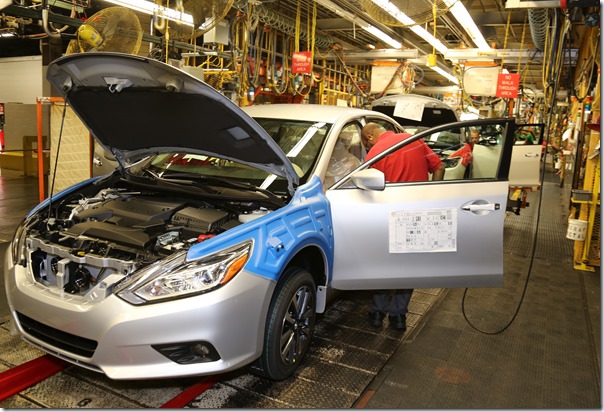2016 Nissan Altima 2.5 SV
If you say to someone “The Big Three,” chances are—at least if (1) they are involved in the auto industry or (2) aren’t involved but are of a certain age—they will say “Ford, GM and Chrysler.” One of the reasons why the Big Three tag became somewhat less descriptive was the rise of the companies that had their origins in Japan, the “Other Big Three,” Toyota, Honda and Nissan.
#interior #electronics
If you say to someone “The Big Three,” chances are—at least if (1) they are involved in the auto industry or (2) aren’t involved but are of a certain age—they will say “Ford, GM and Chrysler.”
One of the reasons why the Big Three tag became somewhat less descriptive was the rise of the companies that had their origins in Japan, the “Other Big Three,” Toyota, Honda and Nissan.
According to Autodata, for example, through the first nine months of the year FCA US LLC (a.k.a., “Chrysler”) had 13.1% of the U.S. market while Toyota’s share is 13.9%.

But while this is completely anecdotal, when it comes to talking about the Japan-based companies in a discussion about competition, it seems as though most people are more of the Coke-Pepsi or Apple-Samsung mindset, citing Toyota and Honda, not Nissan.
I’m not certain that this is because Nissan is somewhat smaller in the market—again, according to Autodata, it has 9% of the U.S. market, below Honda’s 9.4%, so it’s not like there is some huge gulf.
And arguably, Nissan has a more-robust portfolio of vehicles, whether it is in the car or light truck categories, compared with Honda.
When people talk about midsize sedans it is usually Malibu-Fusion or Camry-Accord.
Yet a stalwart in this category is the Nissan Altima, a car that isn’t exactly overlooked—through September its sales were 242,321, which puts it behind Camry (297,453) and Accord (258,619) but ahead of Malibu (170,389) and Fusion 210,462)—probably deserves more consideration for those who are still interested in a sedan.
The Altima has been on the U.S. scene since 1992, when it went into production at the Nissan manufacturing complex in Smyrna, Tennessee. Twelve years later, it proved to be so popular that they added Altima capacity in the Nissan plant in Canton, Mississippi.

(Seeing as how through September there have been 241,619 Nissan Rogue crossovers sold, which is up 13.3 percent, compared with Altima sales being off by 7.7 percent, chances are there is going to be an expansion of capacity for one and a retraction for the other.)
One of the things that Nissan focused on when they did a major refresh for the 2016 model was to focus on efficiency. Part of this is accomplished by a more sleek design, fore and aft. Then it went further than that to the use active grille shutters and underfloor aero covers. What this means is that the vehicle is measurably—as in coefficient of drag (Cd)—slippier than it had been. The 2015 Altima has a Cd of 0.29. The 2016 model is at 0.26—and lower is better.
Another thing they went at was enhancing the strength of the vehicle without adding to the mass, which led to the use of more high-strength steel (e.g., A- and B-pillars).

The aero and the attention to mass leads to a solid fuel-efficiency story, one that has a chapter titled “39 miles per gallon, highway.” Mind you, this is categorized as a midsize car and four people can sit in it comfortably (yes, it is allegedly for five, but you don’t want to be that fifth person).
The car is powered by a 2.5-liter engine that produces 182 hp, which isn’t head-snapping, but then as it is what was once considered a “family sedan,” head snaps aren’t quite the thing.
Engine: 2.5-liter four, 182 hp// Transmission: Xtronic continuously variable//Passenger volume (w/Moonroof, which was on this vehicle as part of the “Convenience Package”): 100.5 cu. ft.//Cargo volume: 15.4 cu. ft. // Fuel economy: 27/39/31 city/highway/combined mpg

RELATED CONTENT
-
Lambo’s Limited Edition Miura Homage
One of the cars that automotive designers everywhere give a hat tip to is the Lamborghini Miura.
-
Honda Re-Imagines and Re-Engineers the Ridgeline
When Honda announced the first-generation Ridgeline in 2005, it opened the press release describing the vehicle: “The Honda Ridgeline re-defines what a truck can be with its true half-ton bed payload capability, an interior similar to a full-size truck and the exterior length of a compact truck.” And all that said, people simply couldn’t get over the way there is a diagonal piece, a sail-shaped buttress, between the cab and the box.
-
Jeeps Modified for Moab
On Easter morning in Moab, Utah, when the population of that exceedingly-hard-to-get-to town in one of the most beautiful settings on Earth has more than doubled, some people won’t be hunting for Easter eggs, but will be trying to get a good look at one of the vehicles six that Jeep has prepared for real-life, fast-feedback from the assembled at the annual Easter Jeep Safari.


.jpg;width=70;height=70;mode=crop)